A Path Planning System for Orchard Mower Based on Improved A* Algorithm
Abstract
1. Introduction
- (1)
- To investigate the motion dynamics of a tracked lawnmower, this study simplifies its motion model based on specific assumptions regarding the orchard environment. Subsequently, a detailed force analysis is conducted on each individual motion mechanism. Employing a grid-based mapping technique, the known orchard environment is accurately modeled.
- (2)
- An improved A* algorithm is proposed to address existing issues in current lawnmower robot full-coverage path planning, thereby ensuring better traversal and coverage of the target area, with the lawnmower robot completely avoiding fruit trees and other obstacles during traversal. This paper validates the practicality of the improved algorithm through simulation experiments and field tests.
- (3)
- A comprehensive investigation is undertaken concerning the clustering of lawnmowers, involving an in-depth analysis of the influence of cluster quantity on path planning within both connected and non-connected orchards. The validation of simulation experiments is accomplished through meticulous field trials, ensuring the rigor of the research findings.
2. Orchard Environmental Information Processing and Motion Analysis of Tracked Lawnmower
2.1. Orchard Environmental Information Rasterization
- (1)
- As fruit trees within the orchard constitute the primary impediments in grid-based environmental modeling, requiring the lawnmower to navigate around them during operation, it is essential to represent obstacle dimensions in the grid map as larger than their real-world counterparts (employing fuzzy processing for modeling fruit trees). This entails incorporating a designated safety margin into the actual dimensions of obstacles within the environment (illustrated in Figure 1). Consequently, safety considerations are not imperative during operation of the lawnmower, and the lawnmower robot can be treated as a point mass while in motion.
- (2)
- Additional impediments within the orchard, such as large rocks and wells, similarly undergo fuzzy processing. In essence, obstacle dimensions in the grid map are magnified compared to their actual dimensions (as depicted in Figure 1).
- (3)
- In this study, the lawnmower robot operates solely within a two-dimensional workspace, and the impact of the lawnmower robot’s height is not considered.
- (4)
- The positions of fruit trees in the orchard are static, so the locations of obstacles on the grid map remain constant throughout the lawnmower robot’s movement.
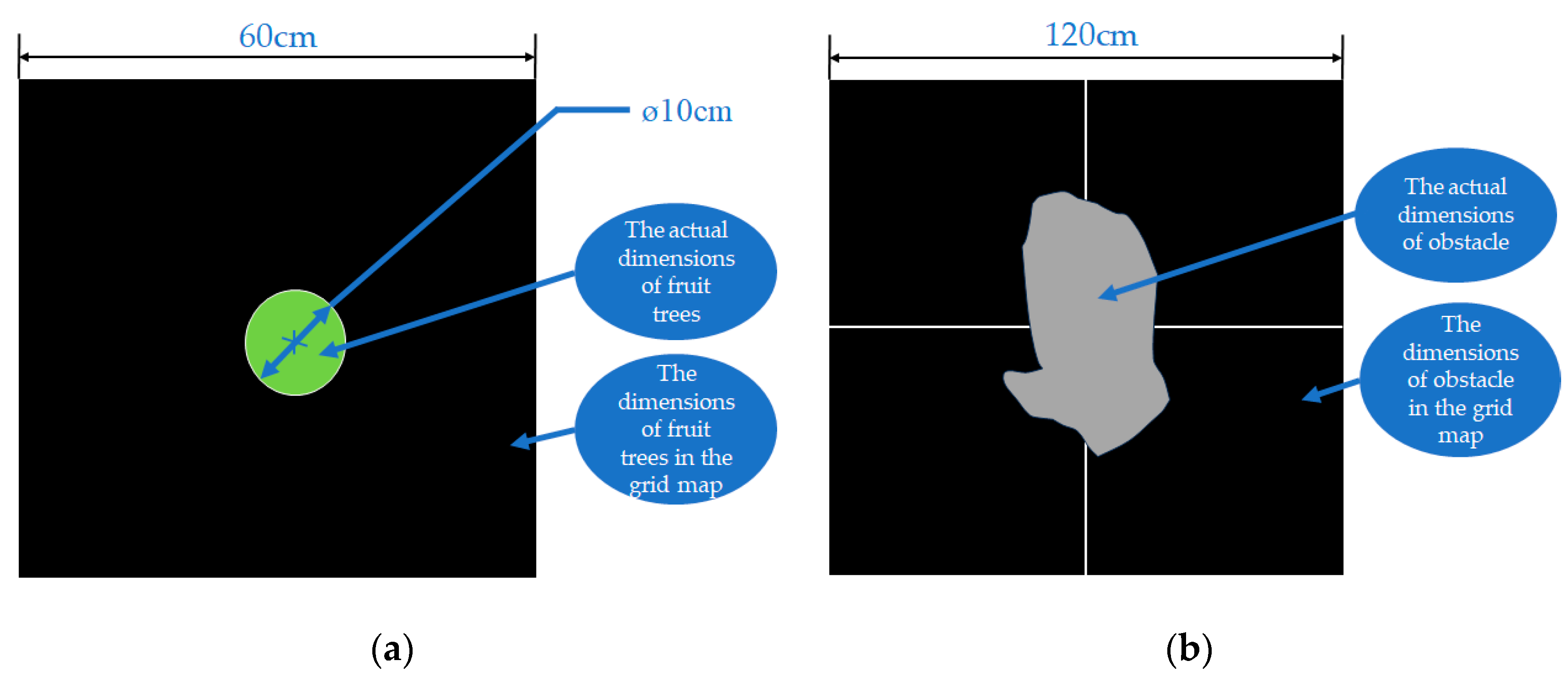
2.2. Motion Analysis of Tracked Lawnower
- (1)
- Orchards in hilly regions mainly refer to those planted on undulating, continuous low hills. These orchards have an absolute height of 500 m, and the relative height does not exceed 200 m. Among them, orchard terrains with slopes of less than 15 degrees, such as flat or gently sloping areas, are suitable for mechanized cultivation and planting. However, when the slope of the orchard terrain exceeds 25 degrees, mechanized operations in the orchard become challenging. Therefore, it is assumed that the tracked lawnmower operates on slopes between 0 and 15 degrees, and the unevenness of the orchard ground is not considered.
- (2)
- The assumption is made that the tracked lawnmower behaves as a rigid body during its motion.
- (3)
- Deformation of the rubber tracks during motion and changes in track tension are not considered.
3. Clustered Lawnmower Task Allocation and Path Planning Methods
3.1. Problem Description and System Framework
- (1)
- The lawnmowers in the cluster are homogeneous robots, meaning each lawnmower carries the same amount of energy.
- (2)
- The environmental information of the orchard is known. The positions of the trees and other obstacles in the orchard are fixed and unchanging, and there are no dynamic obstacles in the orchard.
3.2. Target Area Decomposition
- (1)
- Place the lowest point of the convex polygon representing the area to be covered at the x-axis of the two-dimensional coordinate system, ensuring that the y-coordinate of this lowest point is 0.
- (2)
- Rotate the polygon while maintaining its lowest point on the x-axis. Simultaneously, measure the height of the polygon in real time, i.e., the y-coordinate value of the highest point of the polygon.
- (3)
- Select the direction with the smallest y-coordinate value for the highest point of the polygon, which corresponds to the minimum width direction of the convex polygon. This direction determines the optimal travel direction for the lawnmower, which is the angle in the vertical direction from the x-axis to the minimum width direction of the convex polygon, as illustrated in Figure 5, which represents the search process.
- (1)
- Calculate the energy consumption to traverse each row in the grid map and iteratively determine the estimated energy consumption to cover the entire grid map.
- (2)
- Begin by partitioning the area based on the estimated energy consumption, making sure it is below the energy capacity of each lawnmower P, and perform initial path planning for the segmented areas.
- (3)
- By traversing the initially partitioned regions, the actual walking path is determined, which is used to calculate the actual energy consumption, denoted as , required to traverse the target area.
- (4)
- Divide the areas based on actual energy consumption, ensuring it stays below the energy capacity of each lawnmower, to determine the final subdivision of the area.
3.3. Task Assignment under Multiple Constraints
- (1)
- Rationality: This ensures that all the pending areas in the orchard are allocated to the corresponding lawnmower robots, guaranteeing the complete coverage of all pending areas in the orchard.
- (2)
- Minimization of travel distance: The goal is to minimize the travel distance for each lawnmower robot to reduce their energy consumption.
- (3)
- Fairness: Task allocation should be fair, ensuring that each lawnmower robot has an equal opportunity to perform tasks. (The principle of fairness employed in this study is instead integral as a strategic element for enhancing system efficiency. In this context, fairness refers to the equitable distribution of workloads among the robots, thereby optimizing the overall longevity and maintenance of the system. This approach ensures that no individual robot is subjected to continuous overload, which in turn mitigates the rate of wear and tear on each unit. Consequently, this strategy extends the operational lifespan of the entire fleet and maintains uniform performance levels across all units. Additionally, this principle enhances the system’s adaptability in dynamic operational environments. By ensuring a balanced task allocation, the system is better equipped to manage unforeseen changes, such as varying terrain challenges or individual robot malfunctions, thereby maintaining operational resilience and efficiency.)
3.4. Improved A* Algorithm and Experimental Verification
3.4.1. Improved A* Algorithm
- (1)
- Check if the current node n is the initial node, i.e., if there is a parent node m that precedes the current node.
- (2)
- If the current node n is the initial node, meaning there is no parent node m for the current node n, then use the coordinates of the current node n and the coordinates of the node to be expanded, denoted as r, to calculate the turning cost. When , indicating that the current node n and the node to be expanded r are not on a horizontal or vertical line, and the node r is in the left-up, left-down, right-up, or right-down direction from the current node, the current cost function from the current node n to the node to be expanded r is expressed as:where l represents the distance between two adjacent nodes in the horizontal or vertical direction. When , indicating that the current node n and the node to be expanded r are aligned in the horizontal or vertical direction, the current cost function from the current node n to the node to be expanded r is expressed as:
- (3)
- If the current node n is not the initial node, meaning that the current node n has a parent node m, then the cost of turning is determined using the coordinates of the current node n and its parent node m . When , indicating that the current node n and the parent node m are not collinear in the horizontal or vertical direction, the current cost function from the parent node m to the current node n is expressed as ; when , meaning that the parent node m and the current node n are collinear in the horizontal or vertical direction, the current cost function is expressed as . After these improvements, the overall cost function is , where is calculated using the formula or depending on different situations.
3.4.2. Experiments and Conclusions
4. Path Planning Simulation and Field Experiment Verification with Different Numbers of Clustered Lawnmowers
4.1. Evaluation Metrics for Lawnmower Full-Coverage Path Planning
- (1)
- Repetition rate: Upon completing the orchard traversal, the percentage of all repeated grid cell occurrences to the total number of grid cells, excluding obstacles, is determined.
- (2)
- Omission rate: Upon completing the orchard traversal, the percentage of all missed grid cell occurrences to the total number of grid cells, excluding obstacles, is determined.
- (3)
- Total cost: This refers to the sum of the fuel consumption of the lawnmower and the cost of the lawnmower itself after the lawnmower completes its traversal of the orchard.
4.2. Connected Orchard Coverage Path Planning
4.3. Covering Path Planning in Non-Connected Orchards
4.4. On-Site Experiment Validation
4.4.1. Selection of Experimental Site and Equipment
4.4.2. Experimental Plan
4.4.3. Analysis of Simulation and Field Test Results
- (1)
- Simulation Experiment Results
- (2)
- Field Experiment
- (1)
- The unevenness of the orchard soil caused the lawnmower to experience fluctuations in its path during traversal.
- (2)
- The lawnmower’s traversal in the orchard compacted the weeds, leading to an increase in the lawnmower’s omission rate.
- (3)
- When turning, the lawnmower was affected by weeds, resulting in an increase in turning time.
- (4)
- Measurement errors: The inherent error in the positioning system caused the lawnmower to deviate from the planned path. There were also errors in measuring the lawnmower’s speed using a tape measure and a stopwatch.
- (3)
- Analysis of Experimental Results
- (1)
- The orchard’s uneven terrain caused fluctuations in the lawnmower’s path during traversal.
- (2)
- The lawnmower’s movement in the orchard compressed the weeds, leading to an increase in the omission rate.
- (3)
- While turning, the lawnmower was affected by weeds, resulting in increased turning time.
- (4)
- Measurement errors in the positioning system contributed to deviations from the planned path. Measurement of the lawnmower’s speed using a tape measure and stopwatch introduced errors.
5. Conclusions
Author Contributions
Funding
Data Availability Statement
Conflicts of Interest
References
- Li, Y.; Guo, Z.; Shuang, F.; Zhang, M.; Li, X. Key technologies of machine vision for weeding robots: A review and benchmark. Comput. Electron. Agric. 2022, 196, 106880. [Google Scholar] [CrossRef]
- McCool, C.; Beattie, J.; Firn, J.; Lehnert, C.; Kulk, J.; Bawden, O.; Perez, T. Efficacy of mechanical weeding tools: A study into alternative weed management strategies enabled by robotics. IEEE Robot. Autom. Lett. 2018, 3, 1184–1190. [Google Scholar] [CrossRef]
- Santos Valle, S.; Kienzle, J. Agriculture 4.0—Agricultural Robotics and Automated Equipment for Sustainable Crop Production; FAO: Rome, Italy, 2020. [Google Scholar]
- Saidani, M.; Pan, Z.; Kim, H.; Wattonville, J.; Greenlee, A.; Shannon, T.; Yannou, B.; Leroy, Y.; Cluzel, F. Comparative life cycle assessment and costing of an autonomous lawn mowing system with human-operated alternatives: Implication for sustainable design improvements. Int. J. Sustain. Eng. 2021, 14, 704–724. [Google Scholar] [CrossRef]
- Liao, W.; Zeng, F.; Chanieabate, M. Mechanization of small-scale agriculture in China: Lessons for enhancing smallholder access to agricultural machinery. Sustainability 2022, 14, 7964. [Google Scholar] [CrossRef]
- Wang, S.; Song, J.; Qi, P.; Yuan, C.; Wu, H.; Zhang, L.; Liu, W.; Liu, Y.; He, X. Design and Development of Orchard Autonomous Navigation Spray System. Front. Plant Sci. 2022, 13, 960686. [Google Scholar] [CrossRef] [PubMed]
- Patle, B.K.; Pandey, A.; Parhi, D.R.K.; Jagadeesh, A.J.D.T. A review: On path planning strategies for navigation of mobile robot. Def. Technol. 2019, 15, 582–606. [Google Scholar] [CrossRef]
- Orozco-Rosas, U.; Montiel, O.; Sepúlveda, R. Mobile robot path planning using membrane evolutionary artificial potential field. Appl. Soft Comput. 2019, 77, 236–251. [Google Scholar] [CrossRef]
- Lamini, C.; Benhlima, S.; Elbekri, A. Genetic algorithm based approach for autonomous mobile robot path planning. Procedia Comput. Sci. 2018, 127, 180–189. [Google Scholar] [CrossRef]
- Nazarahari, M.; Khanmirza, E.; Doostie, S. Multi-objective multi-robot path planning in continuous environment using an enhanced genetic algorithm. Expert Syst. Appl. 2019, 115, 106–120. [Google Scholar] [CrossRef]
- Wang, J.; Chi, W.; Li, C.; Wang, C.; Meng, M.Q.H. Neural RRT*: Learning-based optimal path planning. IEEE Trans. Autom. Sci. Eng. 2020, 17, 1748–1758. [Google Scholar] [CrossRef]
- Hart, P.E.; Nilsson, N.J.; Raphael, B. A formal basis for the heuristic determination of minimum cost paths. IEEE Trans. Syst. Sci. Cybern. 1968, 4, 100–107. [Google Scholar] [CrossRef]
- Tsuji, T.; Tanaka, Y.; Morasso, P.G.; Sanguineti, V.; Kaneko, M. Bio-mimetic trajectory generation of robots via artificial potential field with time base generator. IEEE Trans. Syst. Man Cybern. Part C 2002, 32, 426–439. [Google Scholar] [CrossRef]
- Janchiv, A.; Batsaikhan, D.; hwan Kim, G.; Lee, S.G. Complete coverage path planning for multi-robots based on. In Proceedings of the International Conference on Control, Automation and Systems, Gyeonggi, Republic of Korea, 26–29 October 2011; pp. 824–827. [Google Scholar]
- Hazon, N.; Kaminka, G.A. Redundancy, efficiency and robustness in multi-robot coverage. In Proceedings of the 2005 IEEE International Conference on Robotics and Automation, Barcelona, Spain, 18–22 April 2005; pp. 735–741. [Google Scholar]
- Hazon, N.; Kaminka, G.A. On redundancy, efficiency, and robustness in coverage for multiple robots. Robot. Auton. Syst. 2008, 56, 1102–1114. [Google Scholar] [CrossRef]
- Mathi, D.K.; Chinthamalla, R. A hybrid global maximum power point tracking method based on butterfly particle swarm optimization and perturb and observe algorithms for a photovoltaic system under partially shaded conditions. Int. Trans. Electr. Energy Syst. 2020, 30, e12543. [Google Scholar] [CrossRef]
- Mazdin, P.; Barciś, M.; Hellwagner, H.; Rinner, B. Distributed task assignment in multi-robot systems based on information utility. In Proceedings of the 2020 IEEE 16th International Conference on Automation Science and Engineering (CASE), Hong Kong, China, 20–21 August 2020; pp. 734–740. [Google Scholar]
- Bai, X.; Fielbaum, A.; Kronmüller, M.; Knoedler, L.; Alonso-Mora, J. Group-based distributed auction algorithms for multi-robot task assignment. IEEE Trans. Autom. Sci. Eng. 2022, 20, 1292–1303. [Google Scholar] [CrossRef]
- Zlot, R.; Stentz, A.; Dias, M.B.; Thayer, S. Multi-robot exploration controlled by a market economy. In Proceedings of the 2002 IEEE International Conference on Robotics and Automation (Cat. No. 02CH37292), Washington, DC, USA, 11–15 May 2002; Volume 3, pp. 3016–3023. [Google Scholar]
- Lin, B.; Zhao, Y.; Lin, R.; Liu, C. Integrating traffic routing optimization and train formation plan using simulated annealing algorithm. Appl. Math. Model. 2021, 93, 811–830. [Google Scholar] [CrossRef]
- Hustiu, I.; Kloetzer, M.; Mahulea, C. Distributed path planning of mobile robots with ltl specifications. In Proceedings of the 24th International Conference on System Theory, Control and Computing (ICSTCC), Sinaia, Romania, 8–10 October 2020; pp. 60–65. [Google Scholar]
- Atay, N.; Bayazit, B. Mixed-Integer Linear Programming Solution to Multi-Robot Task Allocation Problem; Washington University in St. Louis: St. Louis, MI, USA, 2006. [Google Scholar]
- Liu, J.; Yang, J.; Liu, H.; Tian, X.; Gao, M. An improved ant colony algorithm for robot path planning. Soft Comput. 2017, 21, 5829–5839. [Google Scholar] [CrossRef]
- Zhang, Y.; Pang, D. Research on path planning of mobile robot based on improved ant colony algorithm. In Proceedings of the 2022 IEEE 6th Information Technology and Mechatronics Engineering Conference (ITOEC), Chongqing, China, 4–6 March 2022; Volume 6, pp. 558–563. [Google Scholar]
- Wang, S.; Han, Y.; Chen, J.; He, X.; Zhang, Z.; Liu, X.; Zhang, K. Weed Density Extraction Based on Few-shot Learning through UAV Remote Sensing RGB and Multi-spectral Images in Ecological Irrigation Area. Front. Plant Sci. 2022, 12, 735230. [Google Scholar] [CrossRef] [PubMed]
- Medvedev, M.; Pshikhopov, V. Path planning of mobile robot group based on neural networks. In Proceedings of the Trends in Artificial Intelligence Theory and Applications. Artificial Intelligence Practices: 33rd International Conference on Industrial, Engineering and Other Applications of Applied Intelligent Systems, IEA/AIE 2020, Kitakyushu, Japan, 22–25 September 2020; Proceedings 33; Springer International Publishing: Berlin/Heidelberg, Germany, 2020; pp. 51–62. [Google Scholar]
- Wang, S.; Qi, P.; Zhang, W.; He, X. Development and Application of an Intelligent Plant Protection Monitoring System. Agronomy 2022, 12, 1046. [Google Scholar] [CrossRef]




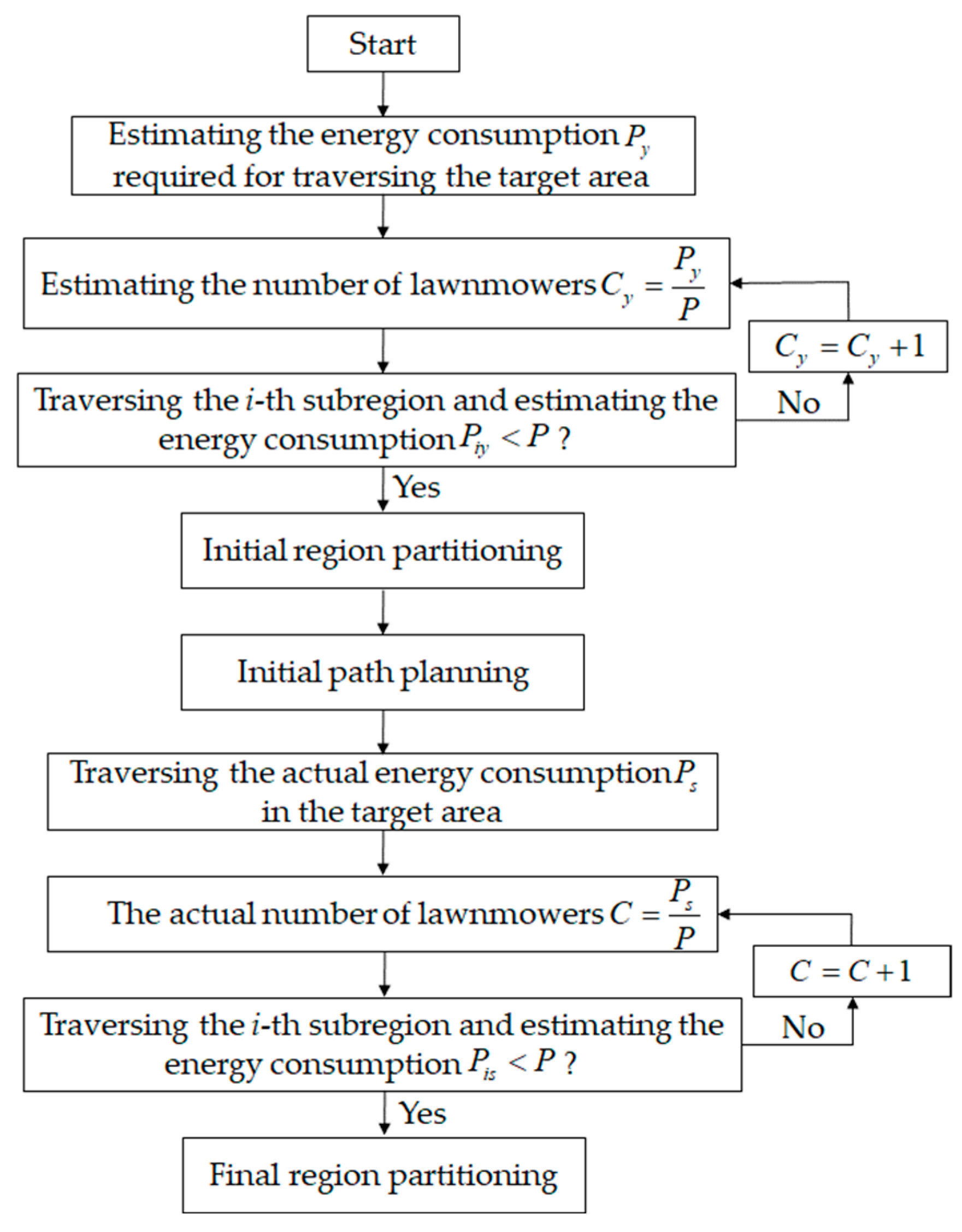

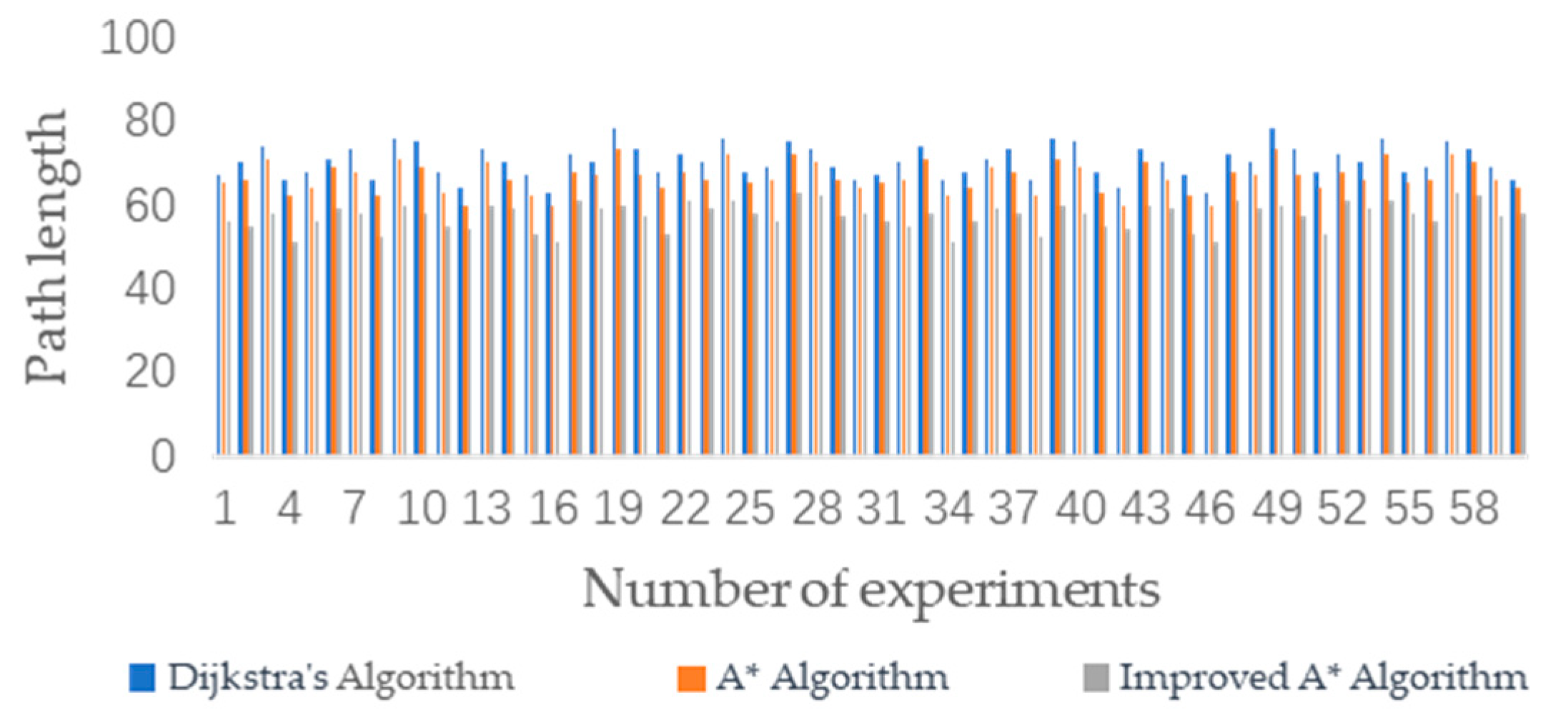


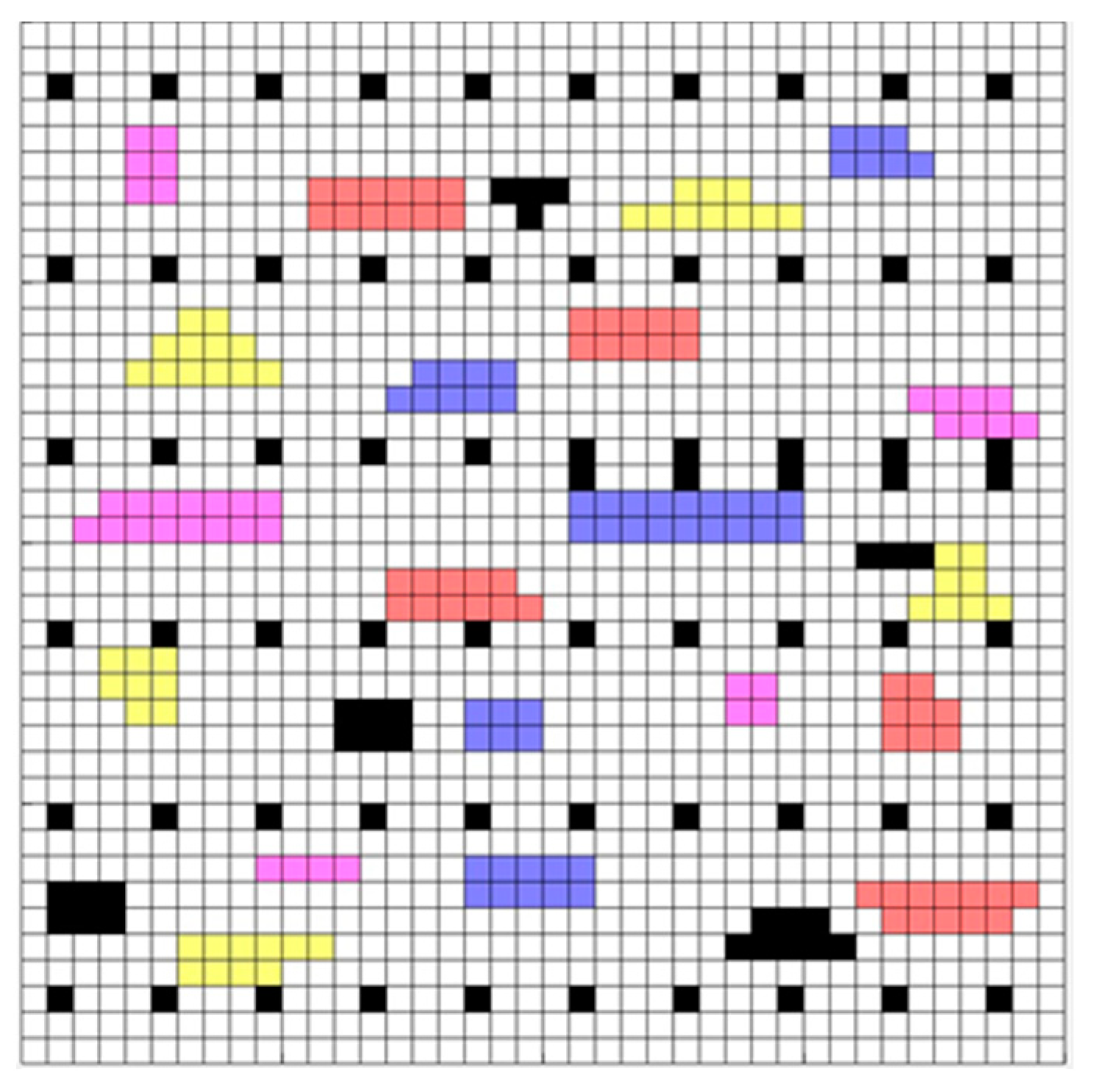


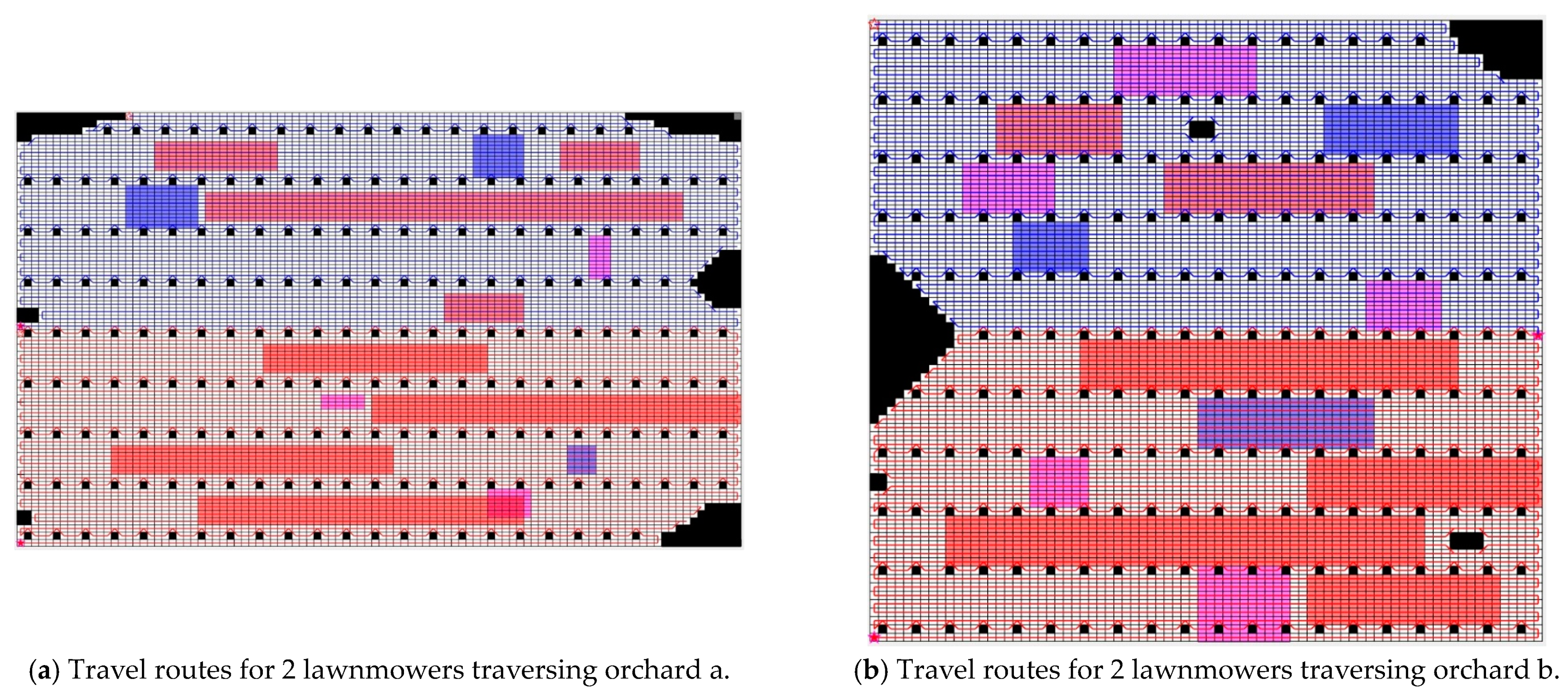

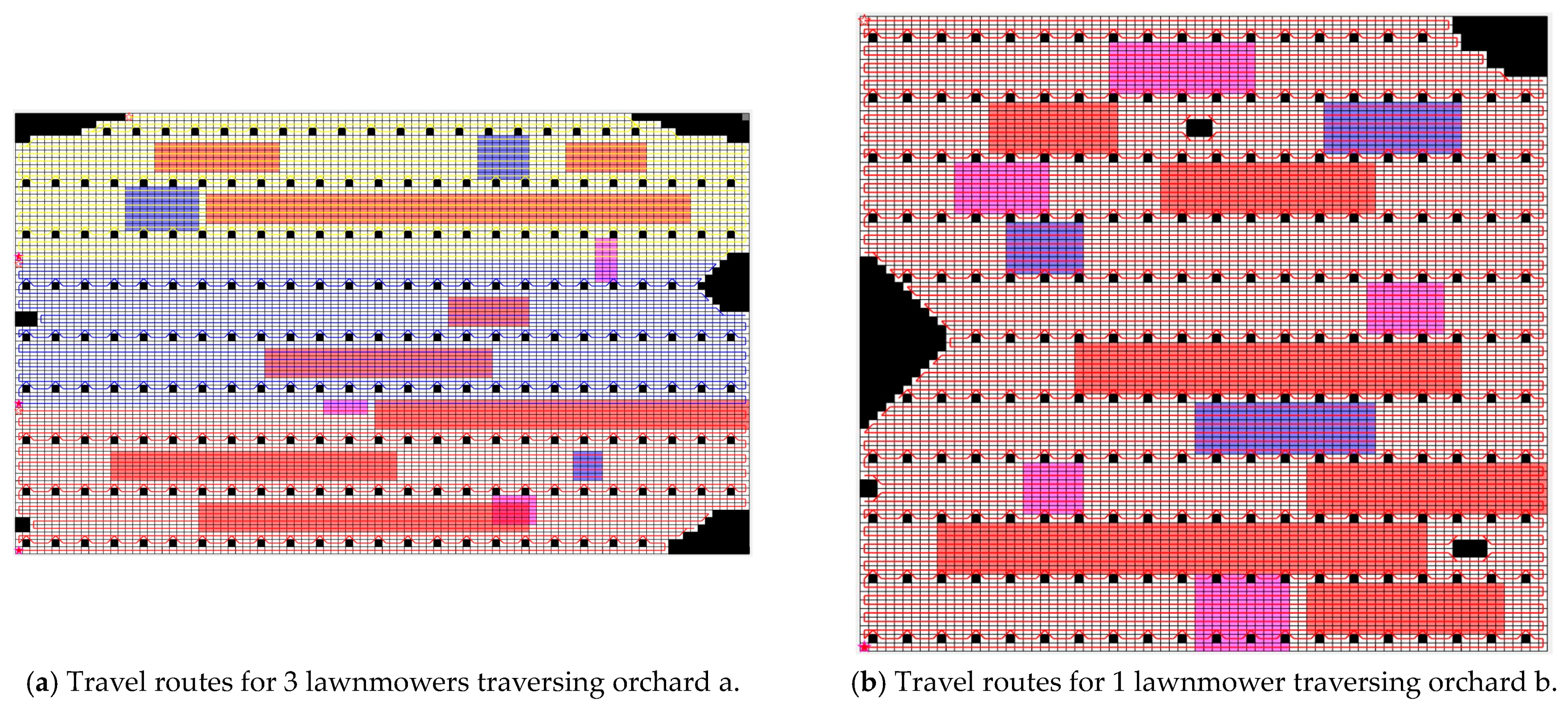

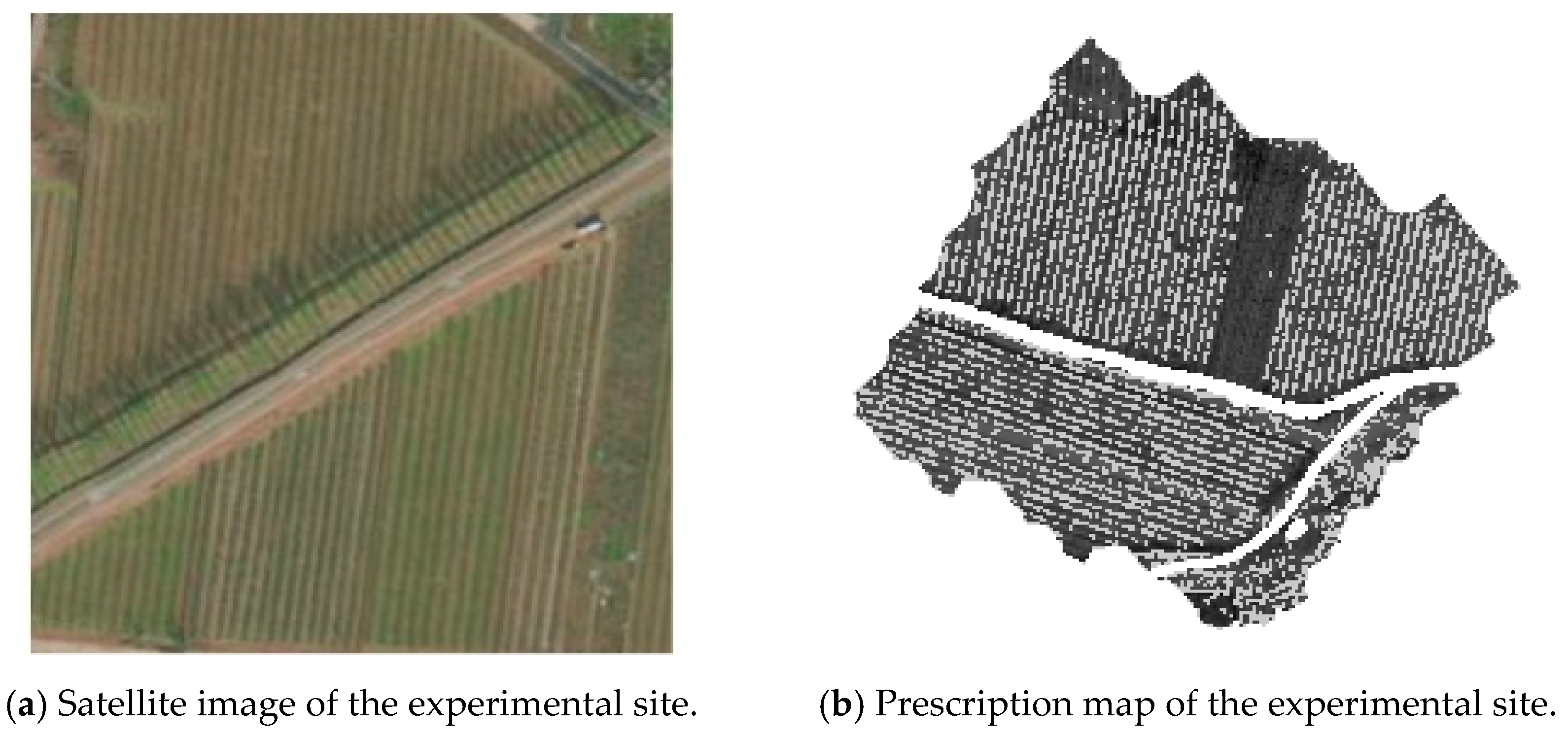

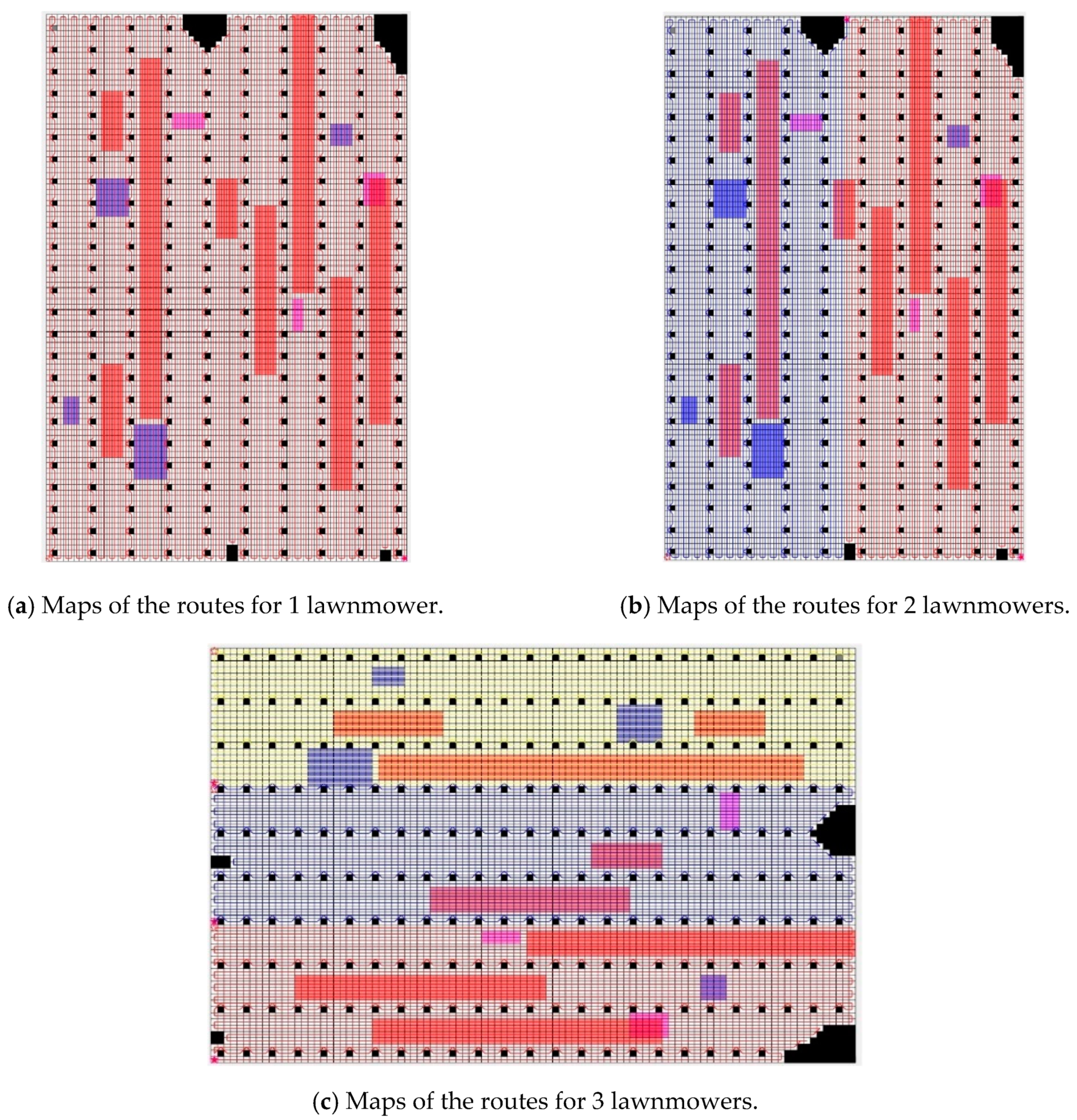
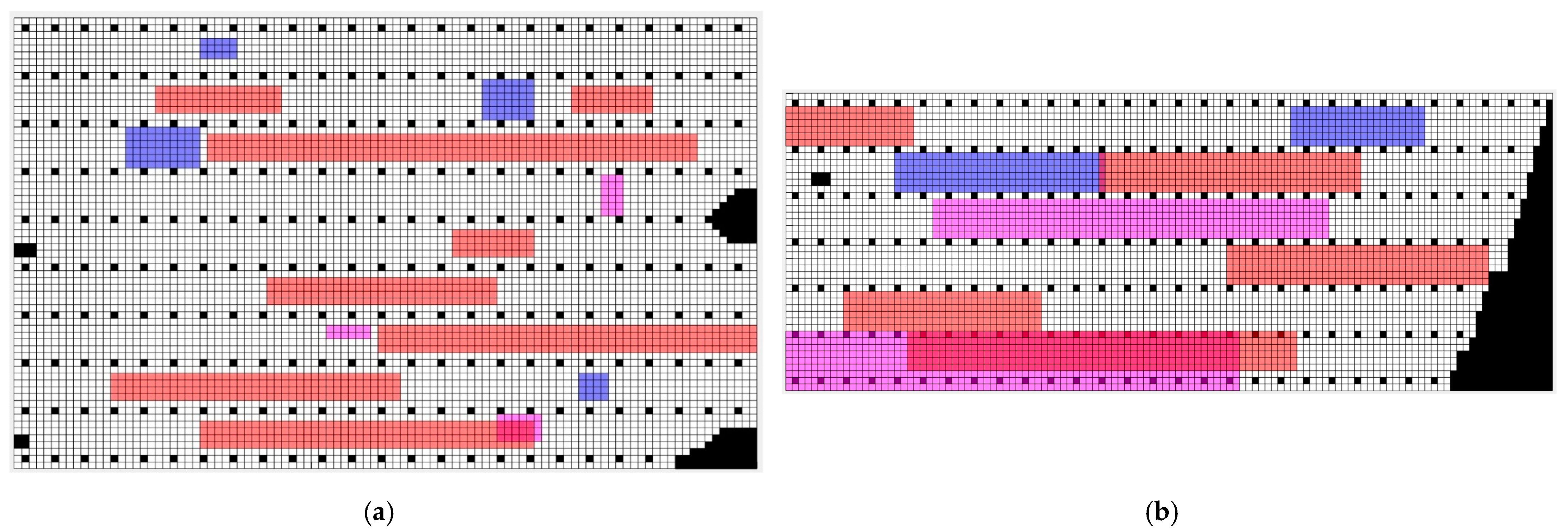
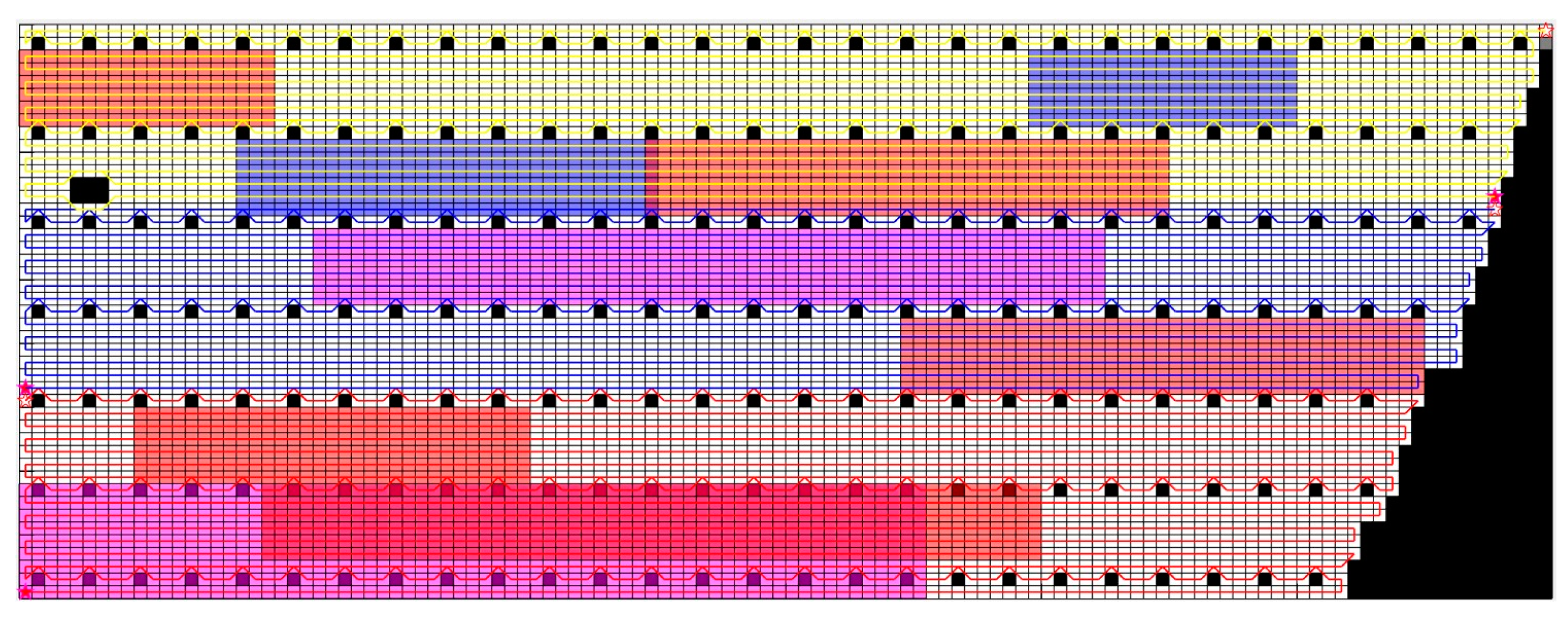


| Algorithm | Path Length (m) | Turn Counts (Times) | Search Time (s) |
|---|---|---|---|
| A* algorithm | 71.79 | 13 | 0.34 |
| Dijkstra’s algorithm | 74.63 | 16 | 0.42 |
| Improved A* algorithm | 62.97 | 8 | 0.30 |
| Algorithm | Average Path Length (m) | Average Turn Counts (Times) | Average Search Time (s) |
|---|---|---|---|
| A* algorithm | 66.53 | 14.22 | 0.38 |
| Dijkstra’s algorithm | 70.34 | 16.57 | 0.35 |
| Improved A* algorithm | 57.61 | 12.36 | 0.32 |
| Number of Lawnmowers | Time Consumption per Lawnmower (s) | Minimum Time Consumption (s) | Energy Consumption per Lawnmower (kJ) | Total Energy Consumption (kJ) | Total Cost (USD) |
|---|---|---|---|---|---|
| 3 | t1 = 461.15; t2 = 499.57; t3 = 465.49 | 499.57 | p1 = 2459.52; p2 = 2664.48; p3 = 2482.56 | 7606.56 | 2880.41 |
| 4 | t1 = 352.89; t2 = 357.68; t3 = 359.22; t4 = 356.33 | 359.22 | p1 = 1882.056; p2 = 1908.72; p3 = 1915.824; p4 = 1899.84 | 7606.44 | 3840.55 |
| 5 | t1 = 283.38; t2 = 286.04; t3 = 282.13; t4 = 288.24; t5 = 286.71 | 288.24 | p1 = 1511.328; p2 = 1525.512; p3 = 1504.224; p4 = 1536.216; p5 = 1529.112 | 7606.392 | 4800.42 |
| 6 | t1 = 246.95; t2 = 214.20; t3 = 249.62; t4 = 247.92; t5 = 215.86; t6 = 250.62 | 250.62 | p1 = 1317.096; p2 = 1142.4; p3 = 1331.304; p4 = 1333.08; p5 = 1145.952; p6 = 1336.632 | 7406.464 | 5760.41 |
| Number of Lawnmowers | Repetition Rate | Omission Rate |
|---|---|---|
| 3 | 6.17% | 0.2131% |
| 4 | 6.10% | 0.2131% |
| 5 | 6.00% | 0.2129% |
| 6 | 6.30% | 0.2128% |
| Time Consumption per Lawnmower (s) | Minimum Time Consumption (s) | Energy Consumption per Lawnmower (kJ) | Total Energy Consumption (kJ) | Total Cost (USD) | |
|---|---|---|---|---|---|
| Orchard a | t1 = 2098.21; t2 = 2068.07; | 2098.21 | p1 = 11,190.48; p2 = 11,029.68; | 22,220.16 | 1877.55 |
| Orchard b | t1 = 2060.47; t2 = 2042.82; | 2060.47 | p1 = 10,989.12; p2 = 10,895.04; | 21,884.16 | 1877.38 |
| Whole orchard | 4158.68 | 4158.68 | 44,104.32 | 44,104.32 | 3754.93 |
| Repetition Rate | Omission Rate | |
|---|---|---|
| Orchard a | 4.12% | 0.24% |
| Orchard b | 4.25% | 0.19% |
| Time Consumption per Lawnmower (s) | Minimum Time Consumption (s) | Energy Consumption per Lawnmower (kJ) | Total Energy Consumption (kJ) | Total Cost (USD) | |
|---|---|---|---|---|---|
| Orchard a | t1 = 1039.92; t2 = 1058.30; t3 = 1044.33; t4 = 1023.74 | 1058.30 | p1 = 5565.12; p2 = 5644.32; p3 = 5571.6; p4 = 5460 | 22,241.04 | 3755.17 |
| Orchard b | t1 = 1021.43; t2 = 1039.04; t3 = 1003.05; t4 = 1039.78 | 1039.78 | p1 = 5447.52; p2 = 5561.04; p3 = 5349.6; p4 = 5545.44 | 21,903.6 | 3754.99 |
| Whole orchard | 2098.07 | 2098.07 | 44,144.64 | 44,144.64 | 7510.16 |
| Repetition Rate | Omission Rate | |
|---|---|---|
| Orchard a | 4.16% | 0.24% |
| Orchard b | 4.27% | 0.19% |
| Time Consumption per Lawnmower (s) | Minimum Time Consumption (s) | Energy Consumption per Lawnmower (kJ) | Total Energy Consumption (kJ) | Total Cost (USD) | |
|---|---|---|---|---|---|
| Orchard a | t1 = 1392.68; t2 = 1399.76; t3 = 1374.30; | 1399.76 | p1 = 7427.52; p2 = 7463.04; p3 = 7329.6; | 22,220.16 | 2813.49 |
| Orchard b | t1 = 4103.29 | 4103.29 | p1 = 21,884.16 | 21,883.2 | 937.11 |
| Whole orchard | 5503.05 | 5503.05 | 44,103.36 | 44,103.36 | 3750.6 |
| Repetition Rate | Omission Rate | |
|---|---|---|
| Orchard a | 4.12% | 0.24% |
| Orchard b | 4.23% | 0.19% |
| Coordinate Positions | (40.18° N, 116.97° E) |
|---|---|
| Orchard area (hectares) | 80.937 |
| Tree row spacing (m) | 3 |
| Tree vertical spacing (m) | 1.5 |
| Name | Value |
|---|---|
| Dimensions (mm) | 900 × 830 × 520 |
| Total weight (kg) | 110 |
| Maximum travel speed (m/s) | 1.5 |
| Cutting width (m) | 0.5 |
| Climbing ability (°) | 25 |
| Fuel tank capacity (L) | 1.2 |
| Working efficiency | 1.01175 hectares/h |
| Number of Lawnmowers | 1 | 2 | 3 |
|---|---|---|---|
| Duration of operation for each lawnmower (s) | 4214.86 | t1 = 2060.81; t2 = 2154.05 | t1 = 1351.35; t2 = 1452.70; t3 = 1410.82 |
| Minimum working time for each lawnmower (s) | 4214.86 | 2154.05 | 1452.72 |
| Energy consumption per lawnmower (kJ) | 22,588.8 | p1 = 11,239.2; p2 = 11,304 | p1 = 7884; p2 = 7634.4; p3 = 7502.4 |
| Total energy consumption (kJ) | 22,588.8 | 22,543.2 | 23,020.8 |
| Total cost (USD) | 937.45 | 1874.29 | 2811.68 |
| Omission rate | 0.155% | 0.154% | 0.153% |
| Repetition rate | 4.013% | 4.029% | 4.012% |
| Number of Lawnmowers | 3 |
|---|---|
| Duration of operation for each lawnmower (s) | t1 = 1209.73 t2 = 1221.53 t3 = 1175.25 |
| Minimum working time for each lawnmower (s) | 1221.53 |
| Energy consumption per lawnmower (kJ) | p1 = 6451.92; p2 = 6514.8; p3 = 6268.08 |
| Total energy consumption (kJ) | 19,234.8 |
| Total cost (USD) | 2811.20 |
| Omission rate | 0.36% |
| Repetition rate | 4.15% |
| Number of Lawnmowers | 3 |
|---|---|
| Duration of operation for each lawnmower (s) | t1 = 1642.76 t2 = 1721.43 t3 = 1667.28 |
| Minimum working time for each lawnmower (s) | 1721.43 |
| Energy consumption per lawnmower (kJ) | p1 = 9866.4; p2 = 10,065.6 p3 = 9422.4 |
| Total energy consumption (kJ) | 29,354.4 |
| Total cost (USD) | 2812.22 |
| Omission rate | 0.30% |
| Repetition rate | 5.63% |
| Number of Lawnmowers | 3 |
|---|---|
| Duration of operation for each lawnmower (s) | t1 = 1463.58 t2 = 1486.67 t3 = 1422.95 |
| Minimum working time for each lawnmower (s) | 1486.67 |
| Energy consumption per lawnmower (kJ) | p1 = 7286.4; p2 = 7567.2 p3 = 7161.6 |
| Total energy consumption (kJ) | 22,015.2 |
| Total cost (USD) | 2811.43 |
| Omission rate | 0.53% |
| Repetition rate | 5.81% |
| Simulated Data | Actual Data | |
|---|---|---|
| Minimum working time for each lawnmower (s) | 1452.72 | 1865.43 |
| Total energy consumption (kJ) | 23,020.8 | 29,354.4 |
| Omission rate | 0.15% | 0.30% |
| Repetition rate | 4.01% | 5.63% |
| Simulated Data | Actual Data | |
|---|---|---|
| Minimum working time for each lawnmower (s) | 2974.25 | 3466.1 |
| Total energy Consumption (kJ) | 42,255.6 | 51,369.6 |
| Omission rate | 0.24% | 0.40% |
| Repetition rate | 4.07% | 5.71% |
Disclaimer/Publisher’s Note: The statements, opinions and data contained in all publications are solely those of the individual author(s) and contributor(s) and not of MDPI and/or the editor(s). MDPI and/or the editor(s) disclaim responsibility for any injury to people or property resulting from any ideas, methods, instructions or products referred to in the content. |
© 2024 by the authors. Licensee MDPI, Basel, Switzerland. This article is an open access article distributed under the terms and conditions of the Creative Commons Attribution (CC BY) license (https://creativecommons.org/licenses/by/4.0/).
Share and Cite
Zhang, M.; Li, X.; Wang, L.; Jin, L.; Wang, S. A Path Planning System for Orchard Mower Based on Improved A* Algorithm. Agronomy 2024, 14, 391. https://doi.org/10.3390/agronomy14020391
Zhang M, Li X, Wang L, Jin L, Wang S. A Path Planning System for Orchard Mower Based on Improved A* Algorithm. Agronomy. 2024; 14(2):391. https://doi.org/10.3390/agronomy14020391
Chicago/Turabian StyleZhang, Mengke, Xiaoguang Li, Ling Wang, Liujian Jin, and Shubo Wang. 2024. "A Path Planning System for Orchard Mower Based on Improved A* Algorithm" Agronomy 14, no. 2: 391. https://doi.org/10.3390/agronomy14020391
APA StyleZhang, M., Li, X., Wang, L., Jin, L., & Wang, S. (2024). A Path Planning System for Orchard Mower Based on Improved A* Algorithm. Agronomy, 14(2), 391. https://doi.org/10.3390/agronomy14020391







